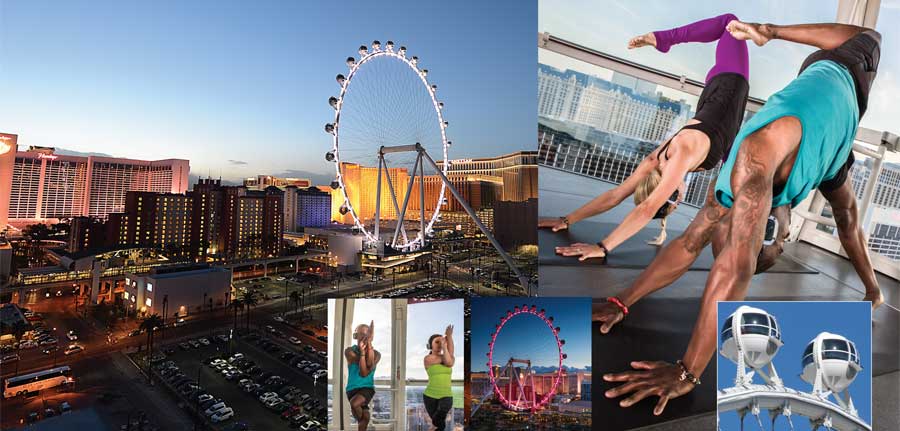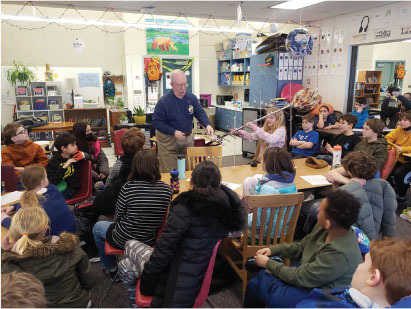July/August 2018
Variables
The Wheel Deal
High Roller by the Numbers
- Height: 550 feet
- Wheel structure: 7.3 million pounds of steel and 112 cables
- Cabin size: 21 feet in diameter with floor-to-ceiling glass windows. Each cabin can accommodate up to 40 people.
- Cabin weight: 44,000 pounds each
- Lighting: 2,000 LEDs with patterns that can be customized for special events and holidays
- Movement: Wheel travels one foot per second and takes about 30 minutes for one full revolution.
- Timeline: Broke ground in February 2012. First ticketed passengers welcomed in March 2014.
Learn more at www.HighRollerLV.com.
If you ride Las Vegas’s High Roller while attending NSPE’s 2018 Professional Engineers Conference or visiting for fun, you can thank PEs for your comfort and stability rotating in the cabins on the world’s tallest observation wheel.
Owned by Caesars Entertainment, the High Roller is a focal point in the LINQ Promenade, an open-air shopping, dining, and entertainment district.
Professional engineers at companies specializing in unique projects oversaw the design, manufacturing, and assembly of the 28 air-conditioned cabins and their internal systems.
Leitner-Poma of America Inc. took the 225-square-foot spherical cabins from design to finished product. The company has worked on aerial systems around the world.
Technical Director Jeff Copeland, P.E., explains that, as the world’s largest wheel, the project was especially exciting—but it also came with challenges. For instance, the stability system had to keep the cabins level within 1.5 degrees; Leitner-Poma managed to get it to within 0.3 degrees. The cabins are so stable that you can even do your Eagle Pose in them—yoga classes are offered several times a week.
Engineering Specialties Group, whose expertise includes unique structures like this one, served as a subcontractor on the cabins. For this project, the company’s primary focus was the HVAC systems. “If you’re going to put 40 people in a glass ball 550 feet in the air in Las Vegas, having air conditioning matters,” says Senior Consultant Mike Deiparine, P.E.
ESG added three levels of A/C redundancy in each cabin in case of failure. And in the event of total power loss, emergency systems will create ventilation. “If Las Vegas goes dark for some reason,” Deiparine explains, “we can still maintain safety with passengers inside. Our primary objective is to get everyone down safely.”
A multitude of systems had to be placed inside the capsule—HVAC, stability, audiovisual, and control—but still allow quick servicing if necessary.
“It looks nice and spacious when you’re inside,” says Copeland, “but you open up the bottom, look in the floor, it looks like you’re opening up the hood of a car. It’s very packed in there.”
Deiparine describes the project as “wild and ambitious.” But the company was able to handle the challenges it encountered by solving “one problem at a time.”
One key to success, Copeland notes, was the coordination with the various parties involved. American Bridge was the general contractor for the wheel, and Arup served as prime design consultant.
Copeland was the lead mechanical/structural engineer for Leitner-Poma’s work. With so many people working on the project, he says, the responsibility of stamping means that you’ve reviewed everything well and “when you stamp, you’ve met the letter of the law.”
As Deiparine puts it, “Everybody on the team saw this as a big deal. Everyone operated responsibly and appropriately; they understand the severity of the situation if we did things wrong. But everyone had a good grasp and worked collaboratively and with the professional responsibility that should be expected.”
Learn more about the project and view assembly, transport, and installation on the Leitner-Poma YouTube channel.

LEFT PHOTO AND BOTTOM RIGHT INSET, LEITNER-POMA. ALL OTHERS, CAESARS ENTERTAINMENT.


 Volunteering at NSPE is a great opportunity to grow your professional network and connect with other leaders in the field.
Volunteering at NSPE is a great opportunity to grow your professional network and connect with other leaders in the field. The National Society of Professional Engineers (NSPE) encourages you to explore the resources to cast your vote on election day:
The National Society of Professional Engineers (NSPE) encourages you to explore the resources to cast your vote on election day:
